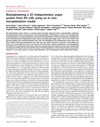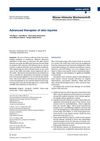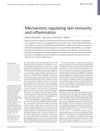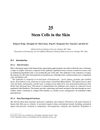TLDR Artificial skin grafts face immune rejection, but stem cells may improve future designs.
The document reviewed the immunological challenges of artificial skin grafts, focusing on immune acceptance and long-term survival. It highlighted the limitations of autografts and the issues of rejection faced by allogeneic or xenogeneic grafts due to immune responses. The role of T lymphocytes and the importance of matching MHC molecules were emphasized in reducing rejection rates. Various strategies, including stem cell-based therapies, bio-engineered skin equivalents, and chemical agents, were explored to improve graft survival and induce tolerance. Despite advancements, no solution completely overcame immunological rejection, and existing engineered skin alternatives did not provide a permanent solution. The potential of stem cells, particularly MSCs and iPSCs, was noted for developing immune-compatible artificial skin, though further research was needed to address immune response challenges.
 77 citations
,
April 2016 in “Science Advances”
77 citations
,
April 2016 in “Science Advances” Researchers created a fully functional, bioengineered skin system with hair from stem cells that successfully integrated when transplanted into mice.
 28 citations
,
September 2015 in “Wiener Klinische Wochenschrift”
28 citations
,
September 2015 in “Wiener Klinische Wochenschrift” New skin substitutes for treating severe burns and chronic wounds are being developed, but a permanent solution for deep wounds is not yet available commercially.
102 citations
,
April 2014 in “PloS one” Wharton’s Jelly stem cells from the umbilical cord improve skin healing and hair growth without scarring.
 610 citations
,
April 2014 in “Nature Reviews Immunology”
610 citations
,
April 2014 in “Nature Reviews Immunology” The document concludes that understanding how the skin's immune system and inflammation work is complex and requires more research to improve treatments for skin diseases.
 106 citations
,
July 2013 in “Advances in wound care”
106 citations
,
July 2013 in “Advances in wound care” UV radiation can help sterilize wounds and promote healing but requires careful use to avoid damaging cells.
64 citations
,
January 2013 in “The journal of investigative dermatology/Journal of investigative dermatology” Human stem cells can help form hair follicles in mice.
 179 citations
,
April 2012 in “Nature Communications”
179 citations
,
April 2012 in “Nature Communications” Regenerated fully functional hair follicles using stem cells, with potential for hair regrowth therapy.
 43 citations
,
January 2011 in “Plastic and Reconstructive Surgery”
43 citations
,
January 2011 in “Plastic and Reconstructive Surgery” Stem cells have great potential for improving wound healing, but more research is needed to find the best types and ways to use them.

Skin stem cells are crucial for maintaining and repairing skin, with potential for treating skin disorders and improving wound healing.






